TTFDNet: Precise Depth Estimation from Single-Frame Fringe Patterns
Abstract
1. Introduction
2. Materials and Methods
3. Results and Discussion
3.1. Establishing a Dataset
3.2. Qualitative and Quantitative Results of Static Targets
3.3. TTFDNet Applied to Dynamic Scene
3.4. Robustness and Generalization Capabilities of TTFDNet
4. Conclusions
Author Contributions
Funding
Institutional Review Board Statement
Informed Consent Statement
Data Availability Statement
Conflicts of Interest
Abbreviations
| Acronyms | Full Forms |
| FPP | Fringe Projection Profilometry |
| FTP | Fourier Transform Profilometry |
| WFT | Windowed Fourier Transform Profilometry |
| WT | Wavelet Transform |
| PSP | Phase Shift Profilometry |
| SPU | Spatial Phase Unwrapping |
| TPU | Temporal Phase Unwrapping |
| MMP | Modulation Measuring Profilometry |
| DNNs | Deep Neural Networks |
| CNN | Convolutional Neural Network |
| PCCD | Precise Contour and Coarse Depth |
| GMDF | Global Multi-Dimensional Fusion |
| PDE | Progressive Depth Extractor |
| FSCE | Fringe Structure Consistency Evaluation |
| ViT | Vision Transformer |
| MHSA | Multi-Head Self-Attention |
| FFN | Feed-Forward Network |
| GeLU | Gaussian Error Linear Unit |
References
- Hu, Y.; Chen, Q.; Feng, S.; Zuo, C. Microscopic fringe projection profilometry: A review. Opt. Lasers Eng. 2020, 135, 106192. [Google Scholar] [CrossRef]
- Huang, L.; Idir, M.; Zuo, C.; Asundi, A. Review of phase measuring deflectometry. Opt. Lasers Eng. 2018, 107, 247–257. [Google Scholar] [CrossRef]
- López-Alba, E.; Felipe-Sesé, L.; Schmeer, S.; A Díaz, F. Optical low-cost and portable arrangement for full field 3D displacement measurement using a single camera. Meas. Sci. Technol. 2016, 27, 115901. [Google Scholar] [CrossRef]
- Zhang, Z.; Chang, C.; Liu, X.; Li, Z.; Shi, Y.; Gao, N.; Meng, Z. Phase measuring deflectometry for obtaining 3D shape of specular surface: A review of the state-of-the-art. Opt. Eng. 2021, 60, 020903. [Google Scholar] [CrossRef]
- Jiang, C.; Jia, S.H.; Xu, Y.; Bao, Q.C.; Dong, J.; Lian, Q. The application of multi-frequency fringe projection profilometry on the measurement of biological tissues. Bio-Med. Mater. Eng. 2015, 26, S395–S403. [Google Scholar] [CrossRef]
- Wu, Y.X.; Cai, X.J.; Zhu, J.J.; Yue, H.M.; Shao, X.P. Analysis and reduction of the phase error caused by the non-impulse system psf in fringe projection profilometry. Opt. Lasers Eng. 2020, 127, 105987. [Google Scholar] [CrossRef]
- Xu, J.; Zhang, S. Status, challenges, and future perspectives of fringe projection profilometry. Opt. Lasers Eng. 2020, 135, 106193. [Google Scholar] [CrossRef]
- Su, X.Y.; Chen, W.J. Fourier transform profilometry: A review. Opt. Lasers Eng. 2001, 35, 263–284. [Google Scholar] [CrossRef]
- Mao, X.F.; Su, X.Y.; Chen, W.J.; Jin, H.L. A flexible calculation on improved Fourier transform profilometry. Optik 2010, 121, 2023–2027. [Google Scholar] [CrossRef]
- Zhang, H.H.; Zhang, Q.C.; Li, Y.; Liu, Y.H. High Speed 3D Shape Measurement with Temporal Fourier Transform Profilometry. Appl. Sci. 2019, 9, 4123. [Google Scholar] [CrossRef]
- Kemao, Q. Two-dimensional windowed Fourier transform for fringe pattern analysis: Principles, applications and implementations. Opt. Lasers Eng. 2007, 45, 304–317. [Google Scholar] [CrossRef]
- Zhong, J.G.; Weng, J.W. Spatial carrier-fringe pattern analysis by means of wavelet transform: Wavelet transform profilometry. Appl. Opt. 2004, 43, 4993–4998. [Google Scholar] [CrossRef]
- Zhang, S. Absolute phase retrieval methods for digital fringe projection profilometry: A review. Opt. Lasers Eng. 2018, 107, 28–37. [Google Scholar] [CrossRef]
- Liu, C.Y.; Wang, C.Y. Investigation of Phase Pattern Modulation for Digital Fringe Projection Profilometry. Meas. Sci. Rev. 2020, 20, 43–49. [Google Scholar] [CrossRef]
- Wu, Z.J.; Guo, W.B.; Zhang, Q.C. Two-frequency phase-shifting method vs. Gray-coded-based method in dynamic fringe projection profilometry: A comparative review. Opt. Lasers Eng. 2022, 153, 106995. [Google Scholar] [CrossRef]
- Zuo, C.; Feng, S.J.; Huang, L.; Tao, T.Y.; Yin, W.; Chen, Q. Phase shifting algorithms for fringe projection profilometry: A review. Opt. Lasers Eng. 2018, 109, 23–59. [Google Scholar] [CrossRef]
- Lu, L.; Suresh, V.; Zheng, Y.; Wang, Y.; Xi, J.; Li, B. Motion induced error reduction methods for phase shifting profilometry: A review. Opt. Lasers Eng. 2021, 141, 106573. [Google Scholar] [CrossRef]
- Jiang, H.; Xu, Y.; Zhang, C.; Xu, Z.-J.; Huang, J.; Tan, H.; Lu, J. An Algorithm Combining the Branch-Cut Method and Rhombus Phase Unwrapping Algorithm. J. Phys. Conf. Ser. 2020, 1634, 012068. [Google Scholar] [CrossRef]
- Xu, C.; Cao, Y.P.; Wu, H.T.; Li, H.M.; Zhang, H.C.; An, H.H. Curtain-type phase unwrapping algorithm. Opt. Eng. 2022, 61, 044103. [Google Scholar] [CrossRef]
- He, X.; Kemao, Q. A comparison of n-ary simple code and n-ary gray code phase unwrapping in high-speed fringe projection profilometry. Opt. Lasers Eng. 2020, 128, 106046. [Google Scholar] [CrossRef]
- Zuo, C.; Huang, L.; Zhang, M.L.; Chen, Q.; Asundi, A. Temporal phase unwrapping algorithms for fringe projection profilometry: A comparative review. Opt. Lasers Eng. 2016, 85, 84–103. [Google Scholar] [CrossRef]
- Wang, J.; Cao, Y.P.; Wu, H.T.; Wei, Z.M. Absolute phase retrieval based on fringe amplitude encoding without any additional auxiliary pattern. Opt. Express 2023, 31, 41952–41966. [Google Scholar] [CrossRef] [PubMed]
- Wei, Z.; Cao, Y.; Wu, H.; Xu, C.; Ruan, G.; Wu, F.; Li, C. Dynamic phase-differencing profilometry with number-theoretical phase unwrapping and interleaved projection. Opt. Express 2024, 32, 19578–19593. [Google Scholar] [CrossRef] [PubMed]
- Zhong, J.G.; Zhang, Y.L. Absolute phase-measurement technique based on number theory in multifrequency grating projection profilometry. Appl. Opt. 2001, 40, 492–500. [Google Scholar] [CrossRef]
- An, H.H.; Cao, Y.P.; Zhang, Y.; Li, H.M. Phase-Shifting Temporal Phase Unwrapping Algorithm for High-Speed Fringe Projection Profilometry. IEEE Trans. Instrum. Meas. 2023, 72, 5009209. [Google Scholar] [CrossRef]
- Yin, Z.Y.; Du, Y.F.; She, P.Y.; He, X.Y.; Yang, F.J. Generalized 2-step phase-shifting algorithm for fringe projection. Opt. Express 2021, 29, 13141–13152. [Google Scholar] [CrossRef]
- Wang, Y.J.; Zhang, S. Novel phase-coding method for absolute phase retrieval. Opt. Lett. 2012, 37, 2067–2069. [Google Scholar] [CrossRef]
- Lu, M.T.; Su, X.Y.; Cao, Y.P.; You, Z.S.; Zhong, M. Modulation measuring profilometry with cross grating projection and single shot for dynamic 3D shape measurement. Opt. Lasers Eng. 2016, 87, 103–110. [Google Scholar] [CrossRef]
- Li, C.M.; Cao, Y.P.; Chen, C.; Wan, Y.Y.; Fu, G.K.; Wang, Y.P. Computer-generated Moire profilometry. Opt. Express 2017, 25, 26815–26824. [Google Scholar] [CrossRef]
- Dirckx, J.J.J.; Decraemer, W.F.; Dielis, G. Phase-shift method based on object translation for full field automatic 3-D surface reconstruction from moire topograms. Appl. Opt. 1988, 27, 1164–1169. [Google Scholar] [CrossRef]
- Eguchi, A.; Milster, T.D. Single-shot phase retrieval with complex diversity. Opt. Lett. 2019, 44, 5108–5111. [Google Scholar] [CrossRef] [PubMed]
- Gupta, A.K.; Mahendra, R.; Nishchal, N.K. Single-shot phase imaging based on transport of intensity equation. Opt. Commun. 2020, 477, 126347. [Google Scholar] [CrossRef]
- He, X.L.; Liu, C.; Zhu, J.Q. Single-shot phase retrieval based on axial phase diversity. Optik 2018, 172, 12–19. [Google Scholar] [CrossRef]
- Zhou, H.Q.; Li, X.; Ullah, N.; Geng, G.Z.; Li, J.J.; Li, X.W.; Wang, Y.T.; Huang, L.L. Single-shot phase retrieval based on anisotropic metasurface. Appl. Phys. Lett. 2022, 120, 161702. [Google Scholar] [CrossRef]
- Spoorthi, G.E.; Gorthi, S.; Gorthi, R.K.S.S. PhaseNet: A Deep Convolutional Neural Network for Two-Dimensional Phase Unwrapping. IEEE Signal Process. Lett. 2019, 26, 54–58. [Google Scholar] [CrossRef]
- Spoorthi, G.E.; Gorthi, R.K.S.S.; Gorthi, S. PhaseNet 2.0: Phase Unwrapping of Noisy Data Based on Deep Learning Approach. IEEE Trans. Image Process. 2020, 29, 4862–4872. [Google Scholar] [CrossRef]
- Feng, S.J.; Chen, Q.; Gu, G.H.; Tao, T.Y.; Zhang, L.; Hu, Y.; Yin, W.; Zuo, C. Fringe pattern analysis using deep learning. Adv. Photonics 2019, 1, 025001. [Google Scholar] [CrossRef]
- Qian, J.M.; Feng, S.J.; Li, Y.X.; Tao, T.Y.; Han, J.; Chen, Q.; Zuo, C. Single-shot absolute 3D shape measurement with deep-learning-based color fringe projection profilometry. Opt. Lett. 2020, 45, 1842–1845. [Google Scholar] [CrossRef] [PubMed]
- Li, Y.X.; Qian, J.M.; Feng, S.J.; Chen, Q.; Zuo, C. Composite fringe projection deep learning profilometry for single-shot absolute 3D shape measurement. Opt. Express 2022, 30, 3424–3442. [Google Scholar] [CrossRef]
- Qi, Z.S.; Liu, X.J.; Pang, J.Q.; Hao, Y.F.; Hu, R.; Zhang, Y.N. PSNet: A Deep Learning Model-Based Single-Shot Digital Phase-Shifting Algorithm. Sensors 2023, 23, 8305. [Google Scholar] [CrossRef]
- Wang, L.L.; Xue, W.K.; Wang, C.Y.; Gao, Q.; Liang, W.J.; Zhang, Y.W. Depth estimation from a single-shot fringe pattern based on DD-Inceptionv2-UNet. Appl. Opt. 2023, 62, 9144–9155. [Google Scholar] [CrossRef] [PubMed]
- Nguyen, H.; Tran, T.; Wang, Y.Z.; Wang, Z.Y. Three-dimensional Shape Reconstruction from Single-shot Speckle Image Using Deep Convolutional Neural Networks. Opt. Lasers Eng. 2021, 143, 106639. [Google Scholar] [CrossRef]
- Nguyen, H.; Wang, Y.Z.; Wang, Z.Y. Single-Shot 3D Shape Reconstruction Using Structured Light and Deep Convolutional Neural Networks. Sensors 2020, 20, 3718. [Google Scholar] [CrossRef] [PubMed]
- Van der Jeught, S.; Dirckx, J.J.J. Deep neural networks for single shot structured light profilometry. Opt. Express 2019, 27, 17091–17101. [Google Scholar] [CrossRef]
- Han, D.; Shin, J.; Kim, N.; Hwang, S.; Choi, Y. TransDSSL: Transformer Based Depth Estimation via Self-Supervised Learning. IEEE Robot. Autom. Lett. 2022, 7, 10969–10976. [Google Scholar] [CrossRef]
- Papa, L.; Russo, P.; Amerini, I. METER: A Mobile Vision Transformer Architecture for Monocular Depth Estimation. IEEE Trans. Circuits Syst. Video Technol. 2023, 33, 5882–5893. [Google Scholar] [CrossRef]
- Yan, L.; Yu, F.Y.; Dong, C. EMTNet: Efficient mobile transformer network for real-time monocular depth estimation. Pattern Anal. Appl. 2023, 26, 1833–1846. [Google Scholar] [CrossRef]
- Wang, L.; Lu, D.Q.; Tao, J.Q.; Qiu, R.W. Single-shot structured light projection profilometry with SwinConvUNet. Opt. Eng. 2022, 61, 114101. [Google Scholar] [CrossRef]
- Zhu, X.J.; Han, Z.Q.; Zhang, Z.Z.; Song, L.M.; Wang, H.Y.; Guo, Q.H. PCTNet: Depth estimation from single structured light image with a parallel CNN-transformer network. Meas. Sci. Technol. 2023, 34, 085402. [Google Scholar] [CrossRef]
- Dosovitskiy, A.; Beyer, L.; Kolesnikov, A.; Weissenborn, D.; Zhai, X.; Unterthiner, T.; Dehghani, M.; Minderer, M.; Heigold, G.; Gelly, S.; et al. An Image is Worth 16x16 Words: Transformers for Image Recognition at Scale. arXiv 2020, arXiv:2010.11929. [Google Scholar]
- Choi, S.; Takahashi, S.; Sasaki, O.; Suzuki, T. Three-dimensional step-height measurement using sinusoidal wavelength scanning interferometer with four-step phase-shift method. Opt. Eng. 2014, 53, 084110. [Google Scholar] [CrossRef]

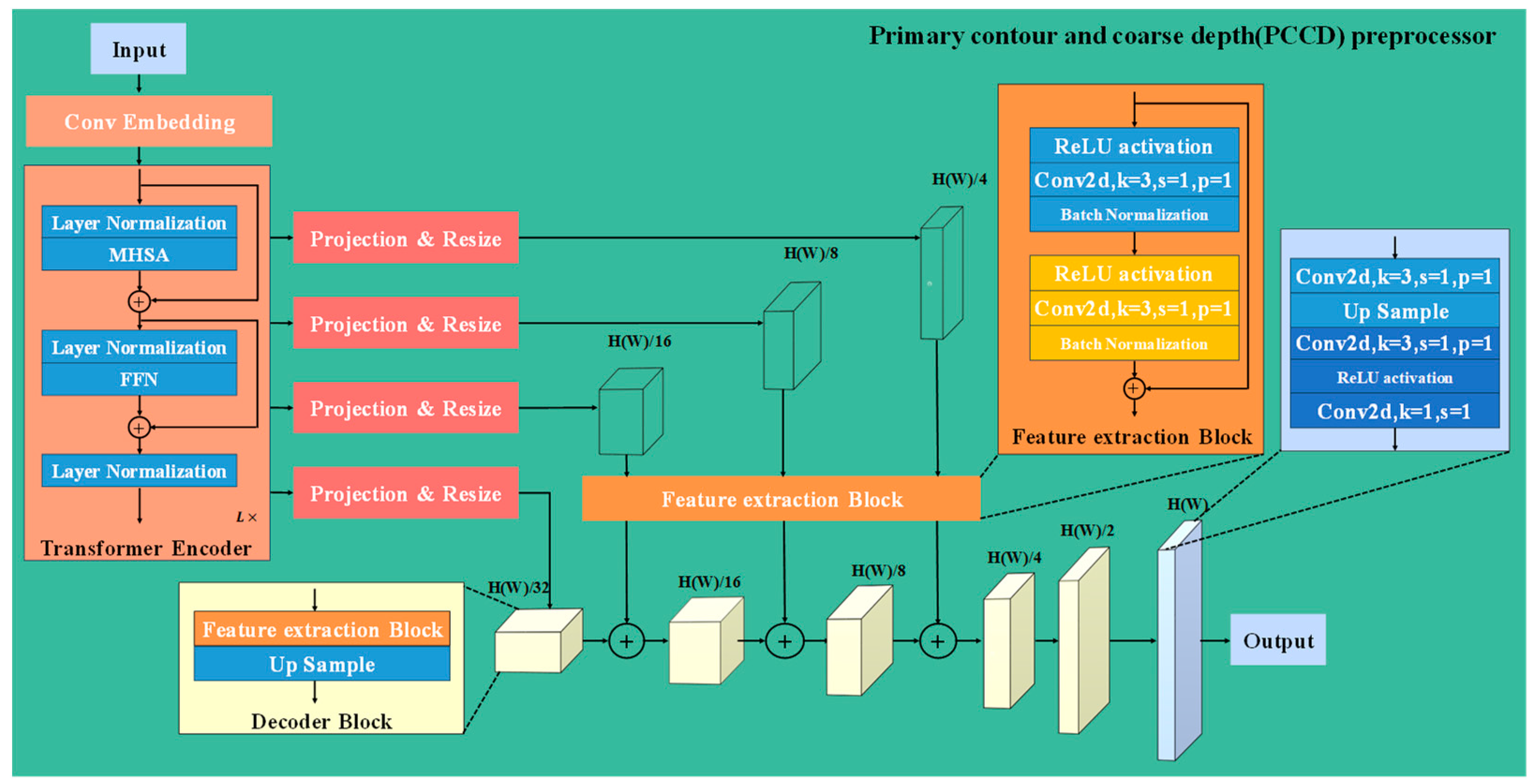
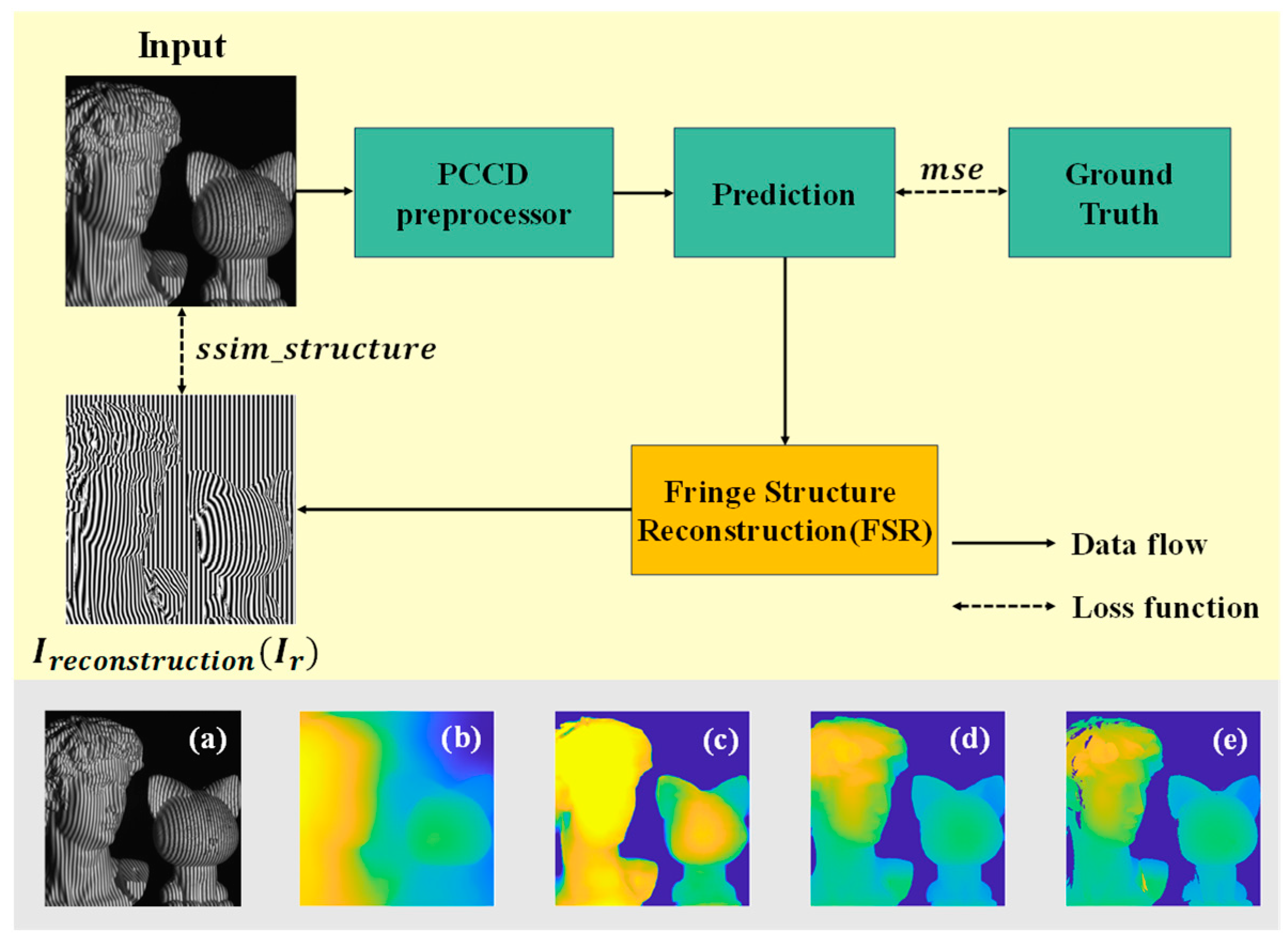
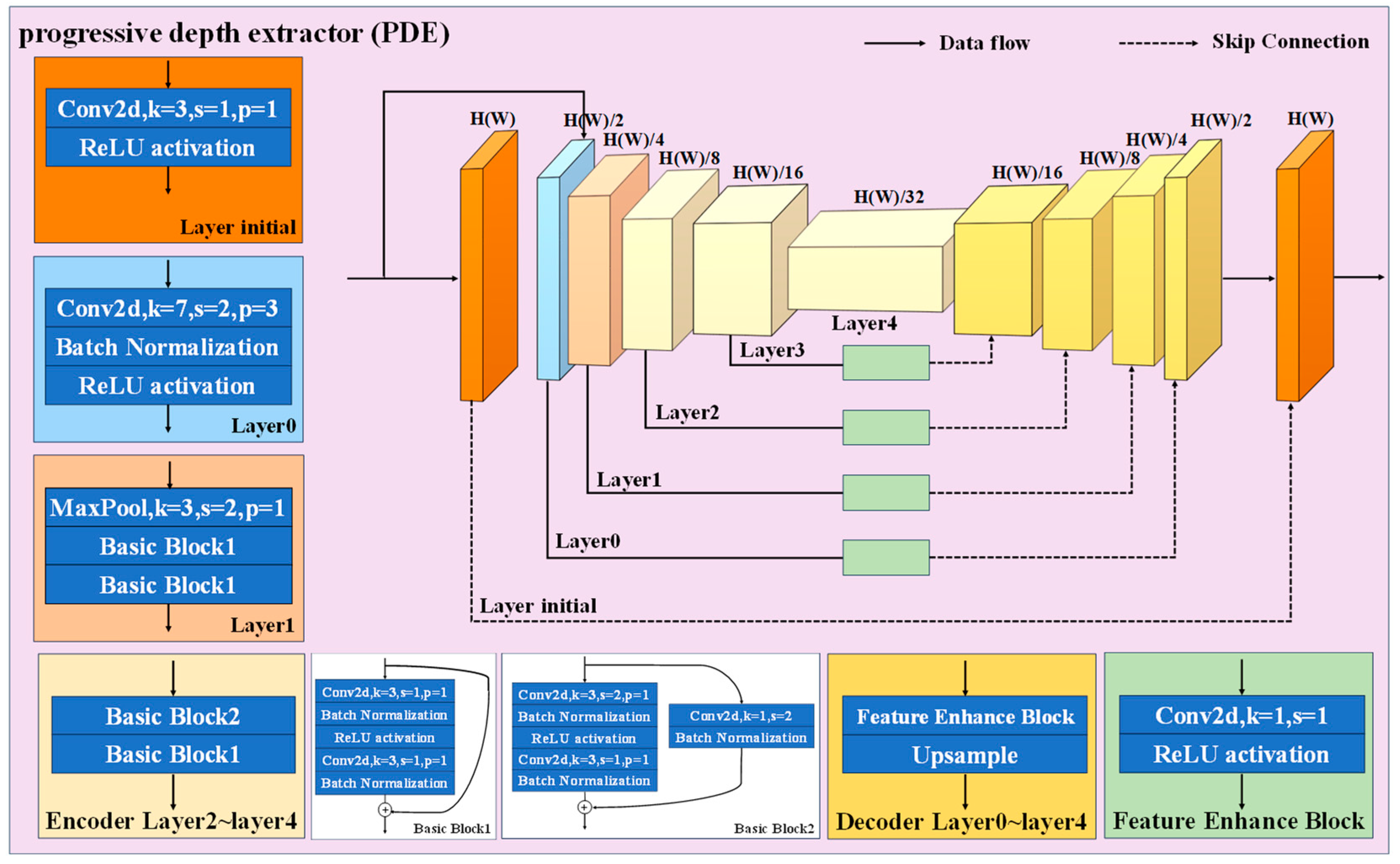

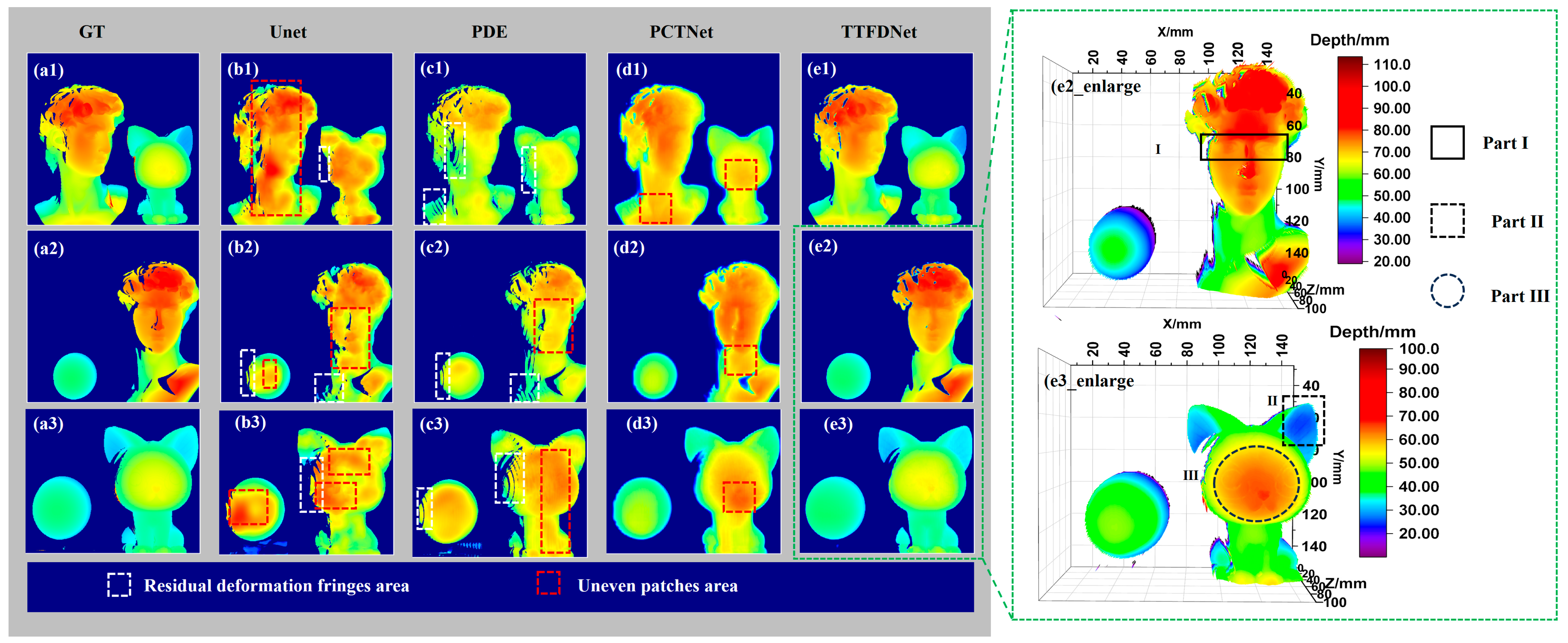
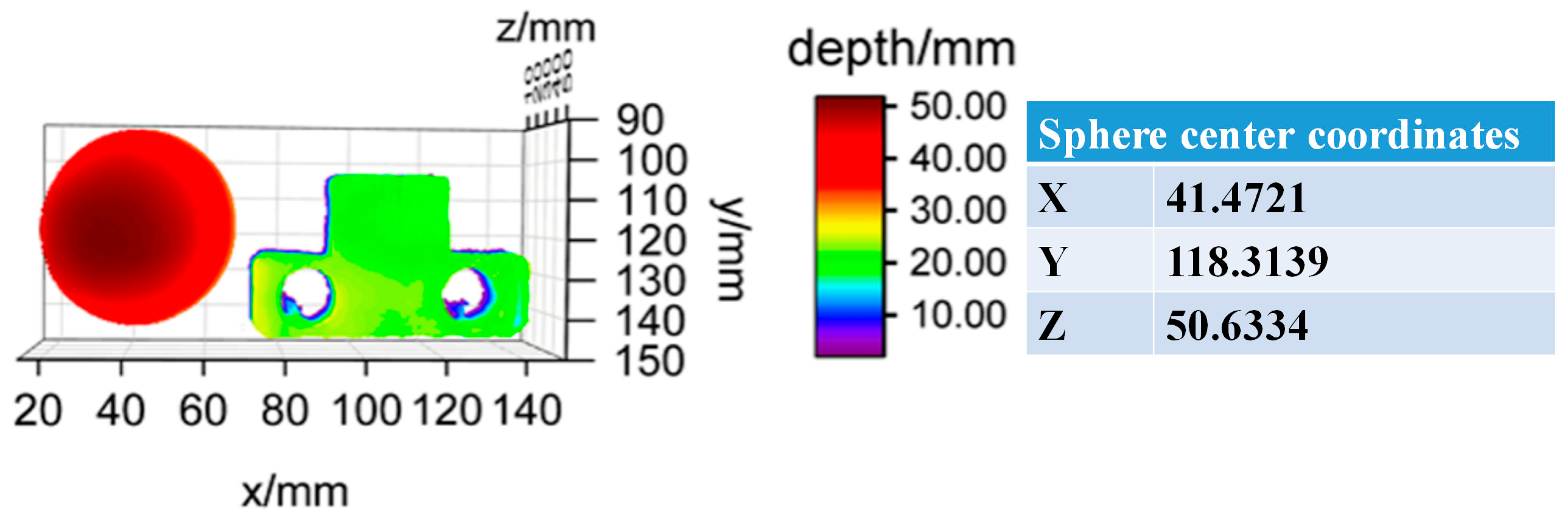

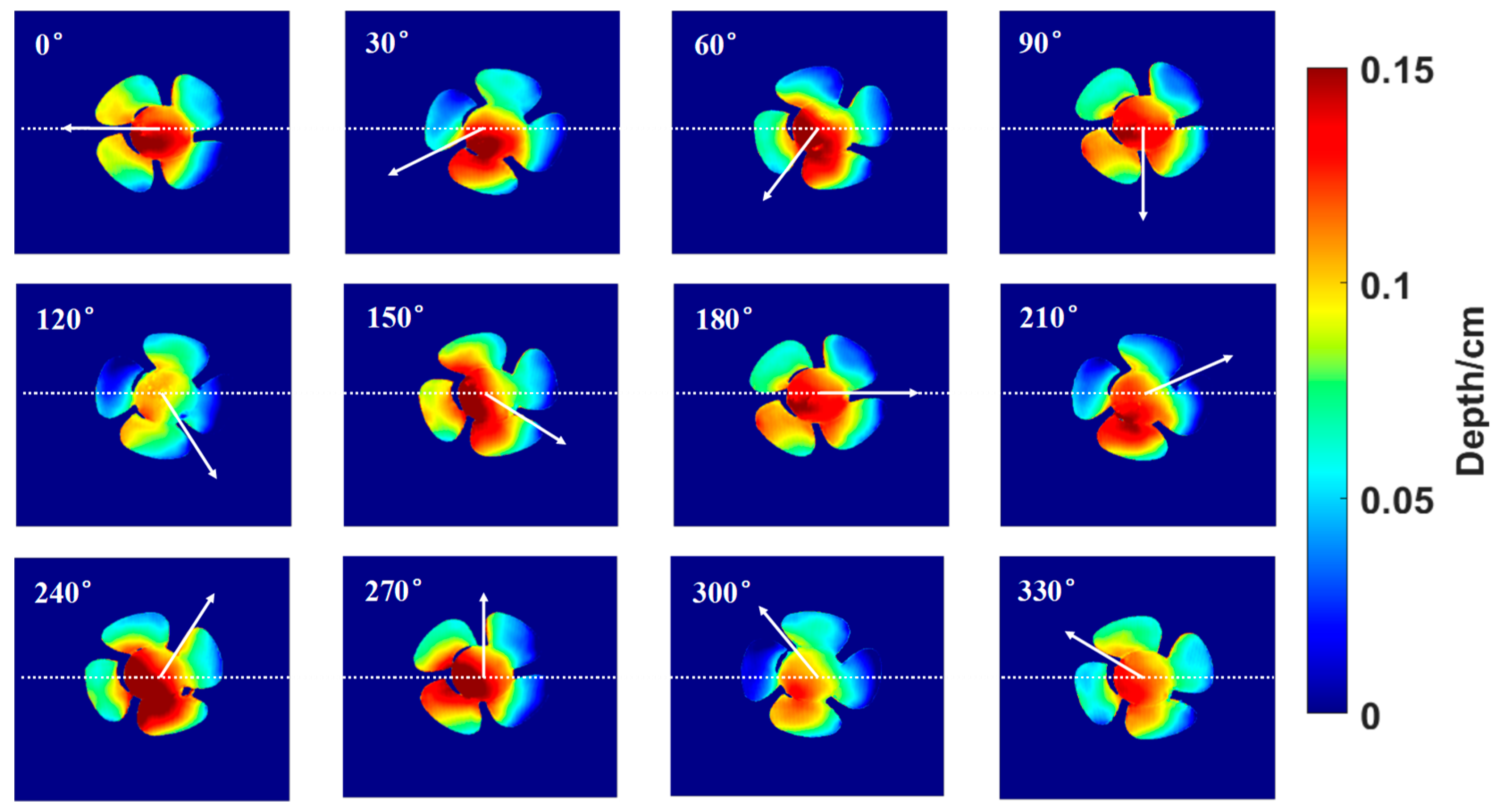

| Thickness | Radius | |
|---|---|---|
| Standard value (mm) | 20.0000 | 25.4000 |
| Predictive value (mm) | 19.9938 | 25.4905 |
| Deviation (μm) | 6.2 | 90.5 |
Disclaimer/Publisher’s Note: The statements, opinions and data contained in all publications are solely those of the individual author(s) and contributor(s) and not of MDPI and/or the editor(s). MDPI and/or the editor(s) disclaim responsibility for any injury to people or property resulting from any ideas, methods, instructions or products referred to in the content. |
© 2024 by the authors. Licensee MDPI, Basel, Switzerland. This article is an open access article distributed under the terms and conditions of the Creative Commons Attribution (CC BY) license (https://creativecommons.org/licenses/by/4.0/).
Share and Cite
Cai, Y.; Guo, M.; Wang, C.; Lu, X.; Zeng, X.; Sun, Y.; Ai, Y.; Xu, S.; Li, J. TTFDNet: Precise Depth Estimation from Single-Frame Fringe Patterns. Sensors 2024, 24, 4733. https://doi.org/10.3390/s24144733
Cai Y, Guo M, Wang C, Lu X, Zeng X, Sun Y, Ai Y, Xu S, Li J. TTFDNet: Precise Depth Estimation from Single-Frame Fringe Patterns. Sensors. 2024; 24(14):4733. https://doi.org/10.3390/s24144733
Chicago/Turabian StyleCai, Yi, Mingyu Guo, Congying Wang, Xiaowei Lu, Xuanke Zeng, Yiling Sun, Yuexia Ai, Shixiang Xu, and Jingzhen Li. 2024. "TTFDNet: Precise Depth Estimation from Single-Frame Fringe Patterns" Sensors 24, no. 14: 4733. https://doi.org/10.3390/s24144733
APA StyleCai, Y., Guo, M., Wang, C., Lu, X., Zeng, X., Sun, Y., Ai, Y., Xu, S., & Li, J. (2024). TTFDNet: Precise Depth Estimation from Single-Frame Fringe Patterns. Sensors, 24(14), 4733. https://doi.org/10.3390/s24144733





